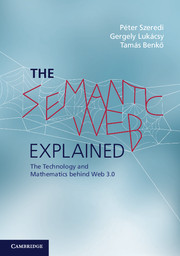3 - Managing and querying RDF sources
Published online by Cambridge University Press: 05 August 2014
Summary
In this chapter we deal with the way in which RDF descriptions are stored, processed and queried as well as the applications and languages involved in the process.
In Section 3.1 we describe how to make RDF meta-information on the web available for search engines. Next, in Section 3.2, we give an overview of development tools which can be used to parse and manage RDF-based sources. In Section 3.3 we describe RDF query languages and show why XML query languages are not suitable for this purpose. Subsequently, in Section 3.4, we discuss the possible reasoning tasks involved in answering RDF queries. Finally, in Section 3.5, we describe problems which arise in the course of optimising RDF queries and outline possible solutions.
RDF descriptions on the web
The RDF language is a generic framework that helps to associate meta-information with resources in a uniform way. RDF is by no means limited to the web, because anything that is identified by a URI can be used in RDF statements. However, as we saw in the previous chapter, practically anything can have a URI: a person, a rucksack, a house etc. This allows us to use RDF in environments other than the web, for example, traditional databases, information integration and other knowledge-intensive systems.
- Type
- Chapter
- Information
- The Semantic Web ExplainedThe Technology and Mathematics behind Web 3.0, pp. 122 - 172Publisher: Cambridge University PressPrint publication year: 2014



